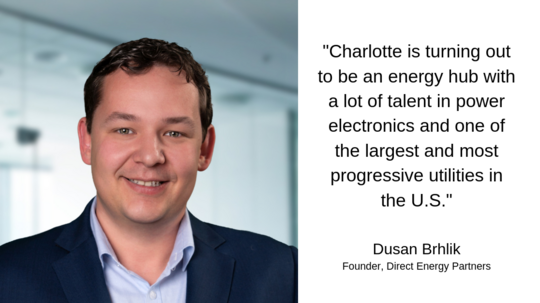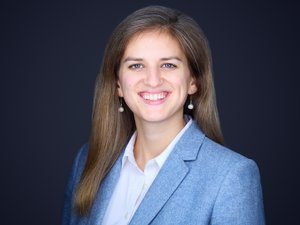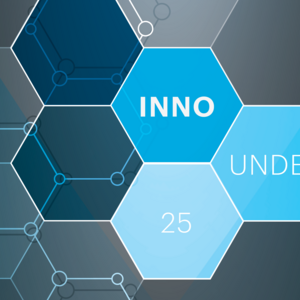
Many of us are unconcerned where our power comes from, as long as our laptops, phones, coffee makers, lights and air conditioning all are running.
But as many of us have also experienced, one bad storm can take down a power grid and suddenly we’re powerless. Literally.
Electrical engineer Dusan Brhlik worked for Bosch for nearly a decade traveling the globe before founding Direct Energy Partners (DEP), a Charlotte-based startup that seeks to move buildings off the grid, at least partially.
“Businesses today do not have access to the types of technology that make their operations more resilient against power outages, efficient and sustainable,” Brhlik said. “Today, when you install a solar or solar plus storage system at a commercial facility, you are effectively connecting it to the utility and any power you end up generating mixes with the utility’s power.”
DEP solves this problem by ensuring that your facility’s demand runs off of renewable energy first and only uses utility power if and when absolutely necessary.
“We call this product the DC Microgrid,” Brhlik said. “We upgrade facilities with DC powered loads (lighting, ventilation and air-conditioning) and connect them to DC sources of energy (solar). This reduces our customer’s operating costs, reduces the total cost of ownership and fast-tracks their ROI in renewables.”
Brhlik, who holds several patents on DC Microgrids and has written on the topic for National Renewable Energy Laboratory, is challenging that convention and has created a solar-powered DC Microgrid option which is currently installed in two North Carolina buildings, one in Charlotte at Hyde Park Partners and one at Fort Bragg.
A Quick History Lesson
First, let’s talk about AC and DC.
In the late 1880s, Thomas Edison and Nikola Tesla were embroiled in a battle now known as the War of the Currents.
Edison developed direct current — current that runs continually in a single direction, like in a battery or a fuel cell. During the early years of electricity, direct current (DC) was the standard in the U.S.
But there was one problem. Direct current is not easily converted to higher or lower voltages.
Tesla believed that alternating current (AC) was the solution to this problem. Alternating current reverses direction a certain number of times per second — 60 in the U.S. — and can be converted to different voltages relatively easily using a transformer.
Today our electricity is still predominantly powered by alternating current, but computers, LEDs, solar cells and electric vehicles all run on DC power. And methods are now available for converting direct current to higher and lower voltages. Since direct current is more stable, companies are finding ways of using high voltage direct current (HVDC) to transport electricity long distances with less electricity loss.
Back to the Future
With electrification right around the corner, the need to deliver more power to homes and businesses will increase exponentially.
“The future of our electrical grid is not centralized where we generate power in one place and distribute it to the masses, but rather decentralized where anybody can generate and consume their own power locally,” Brhlik said. “You no longer have to be a nuclear engineer to produce your own power. If you know how to replace a battery in your remote controller, you know how to maintain your microgrid.”
Clifton Vann, CEO of Hyde Park Partners where DEP operates, understands the value for businesses in having a localized energy source.
“It comes down to business interruption,” Vann said. “If I can run mission-critical items — lights and phones — we’re still open for business.”
“We believe that the best approach to meet this demand for business is by generating your power locally and consume it locally,” Brhlik said. “This is smart, efficient, resilient and most importantly environmentally friendly.”
The microgrid at Hyde Park Partners powers lights and fans in the buildings warehouse space. The system works independently, but also with the traditional power grid to offset some of the energy load.
What’s the Rollout Plan?
Right now DEP is just a two-person team of Brhlik and co-founder Dan Putman.
“We are looking to raise money to productize our microgrid system,” Brhlik said. “The product works well and we have a lot of interest in it. However, to meet the demand and scale it properly we have to be smart about where we focus our resources. For us, this means productizing our technology to ensure that we can meet the demand.”
But, setting up shop in Charlotte has been the right move.
“Strategic partnerships, talent and funding are key to the success for any business,” Brhlik said. “Charlotte is turning out to be an energy hub with a lot of talent in power electronics and one of the largest and most progressive utilities in the U.S. (Duke Energy) is headquartered here along with several financial headquarters.”
As we all sit in our air-conditioned homes and businesses, sipping our coffee while clicking away on laptops, it’s nice to know that companies like DEP are taking steps to secure power sources for the future.
“Our long-term vision is to create a secure and sustainable energy future where buildings across the globe can consume and share their locally generated power,” Brhlik said.








